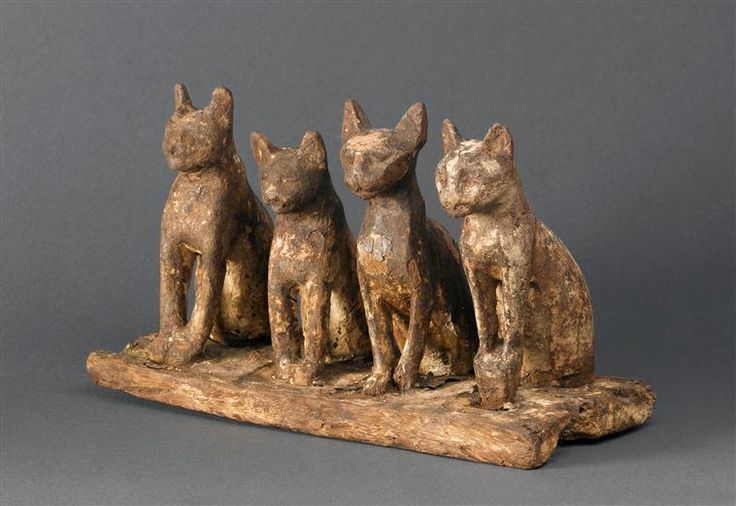Bastet, also known as Bast, was an ancient Egyptian goddess who originally had the role of protecting the Pharaohs. The inhabitants of the lower Nile depicted Bastet as a savage, lion-headed deity. After 1000 BCE, the Egyptians altered her image to the body of a woman and the head of a domesticated cat. Along with her change in appearance, she was also transformed into a peaceful and approachable deity. Instead of Bastet protecting Pharaohs, she was now a nurturer and protector of all households. Families soon began to invite cats inside their homes, thinking that they brought with them the spirit of Bastet. They worshiped these cats because they also hunted mice, snakes, and other pests that ruined their crops and their perishable goods. Bastet’s role as a goddess was further altered when she acquired the trait of fertility. Women would purchase pendants with Bastet and multiple kittens to enhance their fertility.1

Statues and depictions of Bastet vary. She transforms from a beast with a female lion’s head, to a woman with the head of a cat, to a regular black cat with kittens who sometimes held a rattle. Some thought the rattle was actually a musical instrument called a sistrum. Because of this, Bastet was also associated with music and dance. Soon after the sistrum was added to Bastet’s image, the Egyptians used the instrument at festivals where they would worship Bastet. Then, Bastet was depicted wearing a decorative dress, carrying the sistrum in her right hand and a shield in her left, with a bag over her arm.2
The Egyptians had an explanation for why she was transformed from a savage beast to a fertility and music goddess. Bastet was the daughter of Ra, the sun god who was vengeful. From him she got her aggressiveness. Her mother is unknown, but the Egyptians suspect that Ra sent young Bastet to Nubia as a lioness in isolation. There she was able to let out her rage, and then wander back to Egypt as a docile cat. Later an unknown king proclaimed that Bastet was his mother. Egyptian women then believed worshiping her would provide them with many children, as house cats would typically have up to twelve kittens; and one of her sons became king. Experts believe that the baby rattle was mistakenly interpreted as a sistrum, which led to her being known as a music and dance goddess.3

In depictions of wars on the walls of palaces, she was portrayed as a lion, and in homes she was a cat. Although Bastet was a goddess with many traits, that was not all that uncommon. In ancient Egypt gods and goddesses often served more than one purpose. Along with her most common traits, she was also thought of as the goddess of the sun, which she inherited from her father, as well as the goddess of physical pleasure. It was even believed that if a cat ran through a fire, the fire would be put out; therefore, she became the deity of firefighters.4
It is undeniable that Bastet was highly respected. Experts are still unable to determine when Egyptians first began to worship her as well as when her presence faded. Many statues of Bastet and mummified cats have been discovered along the lower Nile, which has led experts to believe that festivals were held there in her honor and locals worshiped her to the highest degree. Although she did have many roles, she is best known as the goddess of protection.5
“His totem animal in black onyx
erect on her haunches poised and aware
he brings in a dream that I might learn
cats are cats and gods—slit-eyed in the sun
in darkness with dilated iris she sees
protector I hope though at times in the night
I tense at her wild amorous cry…”
–Bastet 6
- The Salem Press Encyclopedia, 2o16, s.v. “Bastet (diety),” by Latha Iyer. ↵
- Kathryn Razavi, “The Lioness and the Kittycat: Egypt’s Great Feline Goddess” (Undergraduate Honors Thesis, University of Colorado, 2013), 20-25. ↵
- Nora Scott, “The Cat of Bastet,” The Metropolitan Museum of Art Bulletin, 1 (1958): 1. ↵
- Kathryn Razavi, “The Lioness and the Kittycat: Egypt’s Great Feline Goddess” (Undergraduate Honors Thesis, University of Colorado, 2013), 23. ↵
- Salem Press Encyclopedia, 2o16, s.v. “Bastet (diety),” by Latha Iyer. ↵
- Phyllis Stowell, “Bastet,” Psychological Perspectives 56, no. 3 (2013): 362-364. ↵



67 comments
Nicolas McKay
fantastic article! this must be the origins of the “crazy cat-lady”. All joking aside, it was interesting how you demonstrated the many sides of Bastet, from warrior to fertility and music goddess. It was interesting how so many people viewed her in so many ways and worshiped accordingly. Now I wonder about the myths and origins of other gods who were worshiped around that time as well.
Johnanthony Hernandez
Great article filled with interesting information. I knew that the Egyptians greatly revered cats as incarnations of a god, but I didn’t know the name of the god. I also did not know that over the years, they had changed her shape and mythical powers from a goddess that only protected the Pharaohs to a goddess of fertility and protection of all households.
Mario De Leon
Great article! I found it interesting how the Egyptian people changed Bastet’s image from a savage lion to a domesticated cat. This was probably to make her more friendly to the common people. I also found it interesting how Bastet’s role as a goddess got bigger with more responsibilities. She was first looked at as a protector of the pharaoh and she now is associated with fertility and even music.
Aaron Jaramillo
I really enjoyed reading your article Jennifer. It was very informative and had a good flow. It was interesting to me to learn that people would worship cat and believe they were gods. I never knew they would mummify a cat after they would past. Your pictures and quotes helped your article to be as strong as it is. Great job Jennifer.
Christopher Repka
This was an interesting article on Bastet. I appreciated that you covered how images of Bastet changed over time, that was very interesting. Sometimes, however, it became confusing whether the historians studying Bastet interpreted the images of Bastet in the ways you mentioned, or if it was the Egyptians who wrote these interpretations down. A small matter to distinguish. Great article overall!
Ana Gonzalez
I always knew that the Egyptians were big admirers of cats because they are always portrayed in Egyptian art, but I never knew about Bastet. It was really interesting to read about the way that the interpretation of this Goddess altered over time. At first she was the protector of Pharaohs and in the end she was also the Goddess of music and fertility. This was an interesting read, great job!
Zaraly Frasquillo
I have always had a big interest in learning about the Egyptian gods, due to the fact that they are just so fascinating! I had never heard about Bastet and it is obvious that she meant a lot to the Egyptians. Your article is really informative and I love how you gave an abundance of information but it did not look messy nor was it confusing. Although I do want to birth a king, I really find cats scary so I will not be inviting a cat into my dorm. (Not even the cat outside of Dourghtey)
Alyssa Vela
This article was really informative! I’ve honestly never been very interested in the Egyptian culture, or their fondness of cats. You did however do a good job in keeping me engaged(especially through my lack of knowledge on the subject at hand.) This article was very good structure wise, which resulted in it being very well written overall. Thank you, for the enlightenment on the Egyptian culture as well as their beliefs, you did an awesome job!
Mario Sosa
I never knew that an Egyptian goddess could undergo so many changes. It is interesting how the Egyptians constantly kept on adding new characteristics to Bastet over time. I have not heard much about Egyptian religion so it is very fascinating to read that it was common for their gods to have so many different traits. Very informative article, good job!
Nataly Solis Chavez
The delivery of your article was inconsistent at times, I feel as though the organization of it all could’ve been managed a little bit better but there is no denying that you took the time to do the necessary research because so many of the things mentioned in your article are simply fascinating! For instance, it was interesting to learn how often the goddess was transformed to serve a different purpose! All in all you did a great job!